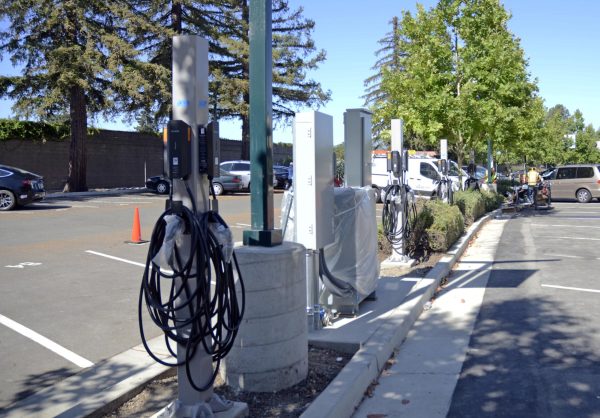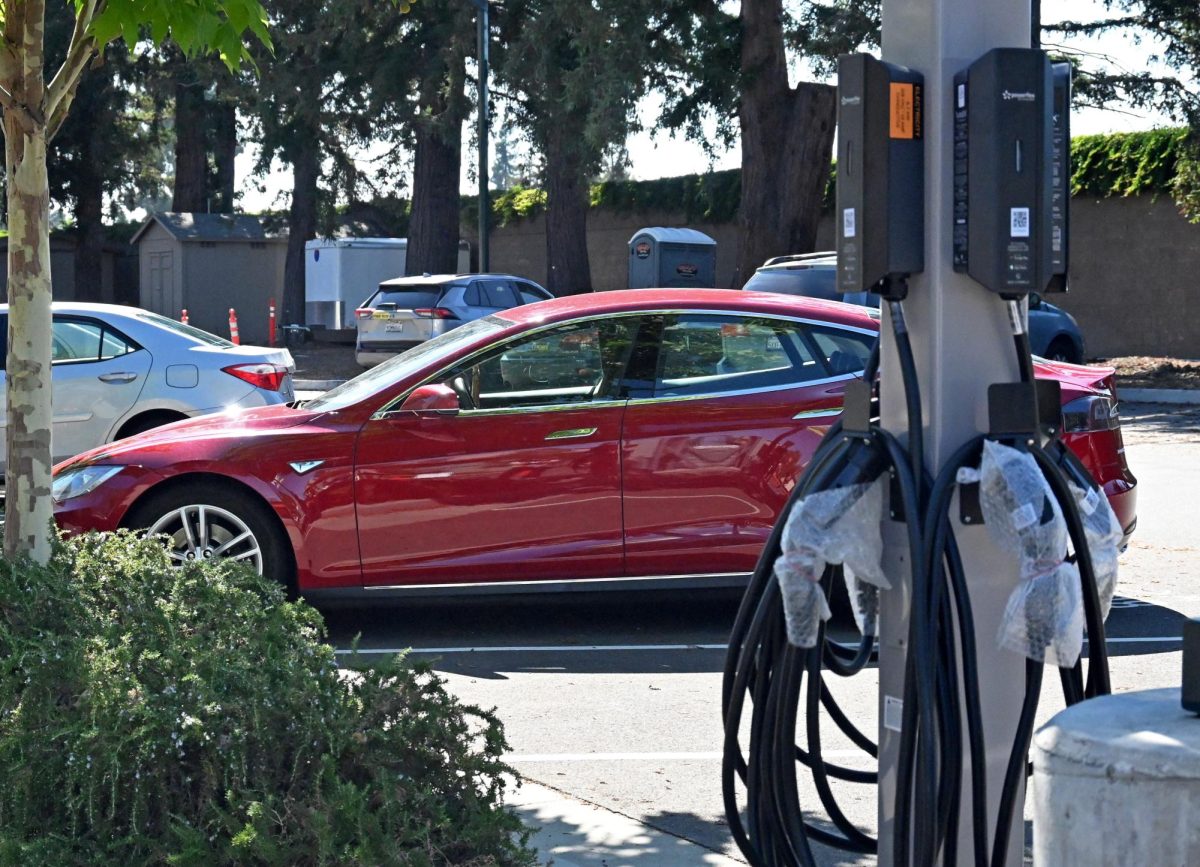President Joe Biden announced plans on April 10 to transition the U.S. to electric vehicles in cooperation with the Environmental Protection Agency (EPA).
The “EV Acceleration Challenge” strives to ensure that two-thirds of all passenger vehicles and a quarter of all trucks sold are all-electric by 2030. The Biden administration gave California the legal authority to require half of all heavy-duty vehicles sold to be fully electric by 2035. That includes garbage trucks, semi trucks, tractors and other high-emission vehicles. The plan aims to address tools and resources, consumer education and support, electric vehicle (EV) fleet expansion and community charging.
Gas vehicles have long been a preferred method of transportation. Drivers only recently began to recognize the extent of their environmental damages. Regular gas-powered passenger vehicles emit approximately 4.6 metric tons of carbon dioxide per year, according to the EPA. In comparison, an average car only weighs around 1 metric ton.
The combustion of gasoline and diesel within the car’s engine releases not only carbon dioxide but also carbon monoxide, nitrogen dioxide and other hydrocarbons. In California alone, vehicle emissions account for 80% of all air pollutants. Inhalation of these pollutants can cause long-term respiratory conditions like asthma, especially in children, and can even lead to premature death in people with lung or heart complications.
Electric vehicles don’t release harmful pollutants because they utilize an electric motor rather than a classic combustion engine. On average, electric vehicles have higher fuel efficiency and cheap refuels. Full recharges at high-powered charging stations typically cost drivers $12 to $16 for 250 miles, compared to $60 to $80 gas refuels for 200 to 400 miles. Among the annual fuel costs for various model year (MY) vehicles of 2022 –– the year that the manufacturers put on the cars –– all EV models boasted costs of less than $1000, with hybrid electric vehicles (HEVs) and hybrid plug-in electric vehicles (PHEVs) coming in at slightly higher $1,000 to $2,000 costs and finally conventional gas vehicles with anywhere from $2,000 to $7,000 costs.
“If you converted the amount of kinetic energy of a gas car and the kinetic energy of an electric car, electric cars would have better gas mileage,” upper school environmental science teacher Jeff Sutton said.

Electric vehicles also hold special privileges on the road. EV owners in California can drive solo on carpool lanes for a period of time. Trips are relatively smooth and quiet –– a perk of the electric motor. Many parking lots provide designated areas for electric vehicles, which often include charging stations as well. The Harker Upper School recently installed five charging stations for EVs in the front parking lot, available for students with parking permits and staff.
Yet, electric vehicles leave environmental footprints. Although the vehicle itself doesn’t contribute to emissions, the manufacturing of the car’s lithium battery and core parts still releases greenhouse gases. The production of a single Tesla Model 3 battery emits anywhere between 2,400 and 16,000 kilograms of carbon dioxide. That’s the equivalent of a gas-powered car driving for 2,500 miles.
“I love the [zero emission] bumper sticker,” Sutton said. “At that point, the vehicle is not producing any emissions because it’s running on battery, but the building of the car, the extraction of the lithium and the charging of the car all [contribute to emissions].”
And it doesn’t stop there: with the rising demand for lithium batteries for electric vehicles, obtaining cobalt, a key component of lithium batteries, has become an issue of its own. In Congo, approximately 100,000 men, women and children mine cobalt by hand for a living. They are exposed to toxic chemicals in the mines. Just one EV battery can contain up to 15,000 grams of refined cobalt.
To support the large influx of electric vehicles, hundreds of thousands of expensive charging stations must be built. Encouraging car owners to choose electric vehicles over gas vehicles also poses a challenge. On average, EVs sell for over $10,000 more than their gas-powered counterparts. Currently, the federal government provides subsidies to electric car owners, but the large expenses might not be sustainable.
“It’s going to be a lot of shifting around,” upper school economics teacher Matt McCorkle said. “We’re going to take some stuff away from you, give it to somebody else. It’s much cleaner in terms of the ethical considerations when you leave it to voluntary exchange. If I say, I want to buy this laptop, I am willing to give up the money. But, if someone takes money from somebody else and gives [me] an extra few hundred dollars just to make it more affordable, that becomes a much bigger question.”

The batteries of electric vehicles typically last for two to three years. Replacing lithium batteries costs $5,000 to upwards of $20,000 per battery. A standard car battery only costs around $45 to $250. Hybrid vehicles, which are half-electric and half-gas, provide a greater distance range than EVs, while also retaining the benefits of high fuel efficiency and low carbon emissions. Hybrids also have lower charging costs than gas vehicles, but replacing the car battery costs from $2,000 to $8,000.
Although it doesn’t come without its tradeoffs, Biden’s plan may be one step closer to a cleaner atmosphere. From an environmental perspective, electric vehicles still outcompete gas vehicles in terms of emissions.
“If even 10% of the cars on the road are EVs, and they aren’t polluting, that would make a big difference,” Green Team Co-President Siddhi Jain (12) said. “But at the same time, if you go back to the source of how they’re made and like the lithium batteries and all the emissions that they produce, it’s a bit of a trade off, but it’s a step in the right direction.”


















![“[Building nerf blasters] became this outlet of creativity for me that hasn't been matched by anything else. The process [of] making a build complete to your desire is such a painstakingly difficult process, but I've had to learn from [the skills needed from] soldering to proper painting. There's so many different options for everything, if you think about it, it exists. The best part is [that] if it doesn't exist, you can build it yourself," Ishaan Parate said.](https://harkeraquila.com/wp-content/uploads/2022/08/DSC_8149-900x604.jpg)




![“When I came into high school, I was ready to be a follower. But DECA was a game changer for me. It helped me overcome my fear of public speaking, and it's played such a major role in who I've become today. To be able to successfully lead a chapter of 150 students, an officer team and be one of the upperclassmen I once really admired is something I'm [really] proud of,” Anvitha Tummala ('21) said.](https://harkeraquila.com/wp-content/uploads/2021/07/Screen-Shot-2021-07-25-at-9.50.05-AM-900x594.png)







![“I think getting up in the morning and having a sense of purpose [is exciting]. I think without a certain amount of drive, life is kind of obsolete and mundane, and I think having that every single day is what makes each day unique and kind of makes life exciting,” Neymika Jain (12) said.](https://harkeraquila.com/wp-content/uploads/2017/06/Screen-Shot-2017-06-03-at-4.54.16-PM.png)








![“My slogan is ‘slow feet, don’t eat, and I’m hungry.’ You need to run fast to get where you are–you aren't going to get those championships if you aren't fast,” Angel Cervantes (12) said. “I want to do well in school on my tests and in track and win championships for my team. I live by that, [and] I can do that anywhere: in the classroom or on the field.”](https://harkeraquila.com/wp-content/uploads/2018/06/DSC5146-900x601.jpg)
![“[Volleyball has] taught me how to fall correctly, and another thing it taught is that you don’t have to be the best at something to be good at it. If you just hit the ball in a smart way, then it still scores points and you’re good at it. You could be a background player and still make a much bigger impact on the team than you would think,” Anya Gert (’20) said.](https://harkeraquila.com/wp-content/uploads/2020/06/AnnaGert_JinTuan_HoHPhotoEdited-600x900.jpeg)

![“I'm not nearly there yet, but [my confidence has] definitely been getting better since I was pretty shy and timid coming into Harker my freshman year. I know that there's a lot of people that are really confident in what they do, and I really admire them. Everyone's so driven and that has really pushed me to kind of try to find my own place in high school and be more confident,” Alyssa Huang (’20) said.](https://harkeraquila.com/wp-content/uploads/2020/06/AlyssaHuang_EmilyChen_HoHPhoto-900x749.jpeg)





